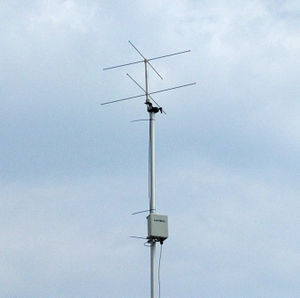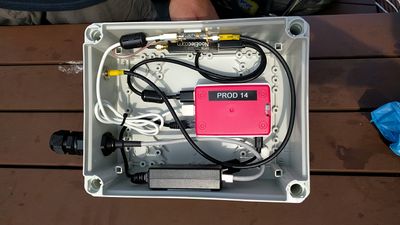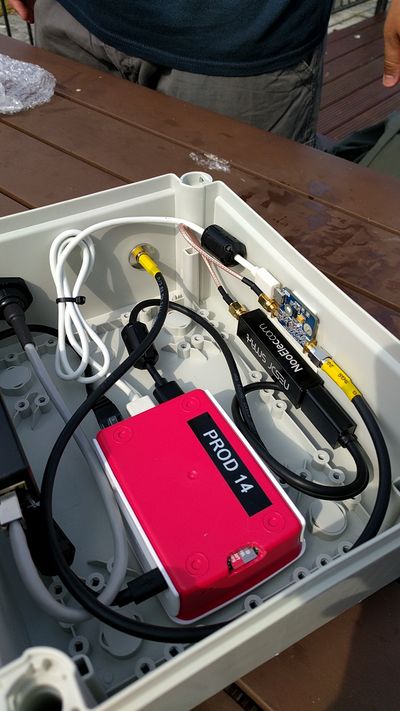Difference between revisions of "No rotator"
From SatNOGS Wiki
(- Remove broken link) (Tag: Visual edit) |
(categories, layout) |
||
| Line 11: | Line 11: | ||
}} | }} | ||
| + | == Introduction == | ||
No-Rotator ground station uses a static antenna usually in VHF. | No-Rotator ground station uses a static antenna usually in VHF. | ||
A Turnstile antenna that tunes at ~137MHz is used for NOAA satellites. | A Turnstile antenna that tunes at ~137MHz is used for NOAA satellites. | ||
| Line 19: | Line 20: | ||
{{Message| Same setup could be used for a ground station with rotator.}} | {{Message| Same setup could be used for a ground station with rotator.}} | ||
| − | =Bill of Materials= | + | == Bill of Materials == |
The materials are categorized into 4 groups: | The materials are categorized into 4 groups: | ||
| Line 74: | Line 75: | ||
|} | |} | ||
| − | =Assembly | + | == Assembly Instructions == |
[[File:Liverpool_no_rotator_1.jpeg|400px|thumb|right|Inside the box 1]] | [[File:Liverpool_no_rotator_1.jpeg|400px|thumb|right|Inside the box 1]] | ||
[[File:IMG 20170621 100727.jpg|400px|thumb|right|RF Detail]] | [[File:IMG 20170621 100727.jpg|400px|thumb|right|RF Detail]] | ||
| − | + | == Operation == | |
| − | =Operation= | ||
Follow the instructions for setting up the [[Raspberry_Pi_3|Raspberry Pi 3]] to setup your station. | Follow the instructions for setting up the [[Raspberry_Pi_3|Raspberry Pi 3]] to setup your station. | ||
Then consult the [[Operation]] page for getting started on our Network. | Then consult the [[Operation]] page for getting started on our Network. | ||
| + | |||
| + | [[Category:Build]] | ||
| + | [[Category:Hardware]] | ||
Revision as of 22:30, 19 January 2020
| No-Rotator | |
|---|---|
| Information | |
| Type: | No-Rotator ground station for SatNOGS network. |
| Cost: | |
| Release Information | |
| Status: | Working |
| Latest Release: | [ ] |
| Repository: | [] |
| Documentation: | [] |
Introduction
No-Rotator ground station uses a static antenna usually in VHF. A Turnstile antenna that tunes at ~137MHz is used for NOAA satellites. Some Turnstile antenna design, are wide enough to receive VHF band at 144 - 146 MHz. For more vertical satellite passes, UHF Helical antennas receive satellites at 432 - 438 MHz, e.g. [1]
Bill of Materials
The materials are categorized into 4 groups:
- RF components
- Client components
- Hardware components
- Tools
| Part | Qty | Source | Price per Unit ($) |
| RTL-SDR | 1 | [2] | 21 |
| SMA Male to SMA Male Connector Pigtail Cable | 1 | [3] | 1 |
| LNA with FM-Notch | 1 | [] | 35 |
| RG-58 cable, 2.2m | 1 | [] | - |
| SMA Male cable connector | 1 | [] | - |
| Type-N Female chassis connector | 1 | [] | - |
| Type-N Male cable connector | 2 | [] | - |
| Turnstile antenna with Type-N Female connector | 1 | [] | - |
| Raspberry Pi 3 - Model B | 1 | [4] | 40 |
| Raspberry Pi 3 Case | 1 | [5] | 5 |
| SD Card, Class 10, 32GB, Kingston, Sandisk | 1 | [6] | 10 |
| Micro USB Active POE Splitter Power for Raspberry pi 3 Board (48V to 5V 2.4A) | 1 | [7] | 12 |
| POE-48-24W-BULK POE Adapter 48V, 0.5A, 24W | 1 | [8] | 13 |
| Ethernet LAN RJ45 Outdoor Waterproof Connector | 1 | [9] | 3.6 |
| Cable, Male USB-Micro to Male USB-A, L=25cm | 1 | [] | 1 |
| Cable, Female USB-A to Male USB-A, L=25cm | 1 | [] | 1 |
| Ring Core Ferrite Bead for USB cables | 2 | [10] | 0.8 |
| Ethernet cable, outdoor, CAT5 or higher, L=?m | 1 | [] | |
| 1 | [] |
Assembly Instructions
Operation
Follow the instructions for setting up the Raspberry Pi 3 to setup your station. Then consult the Operation page for getting started on our Network.


